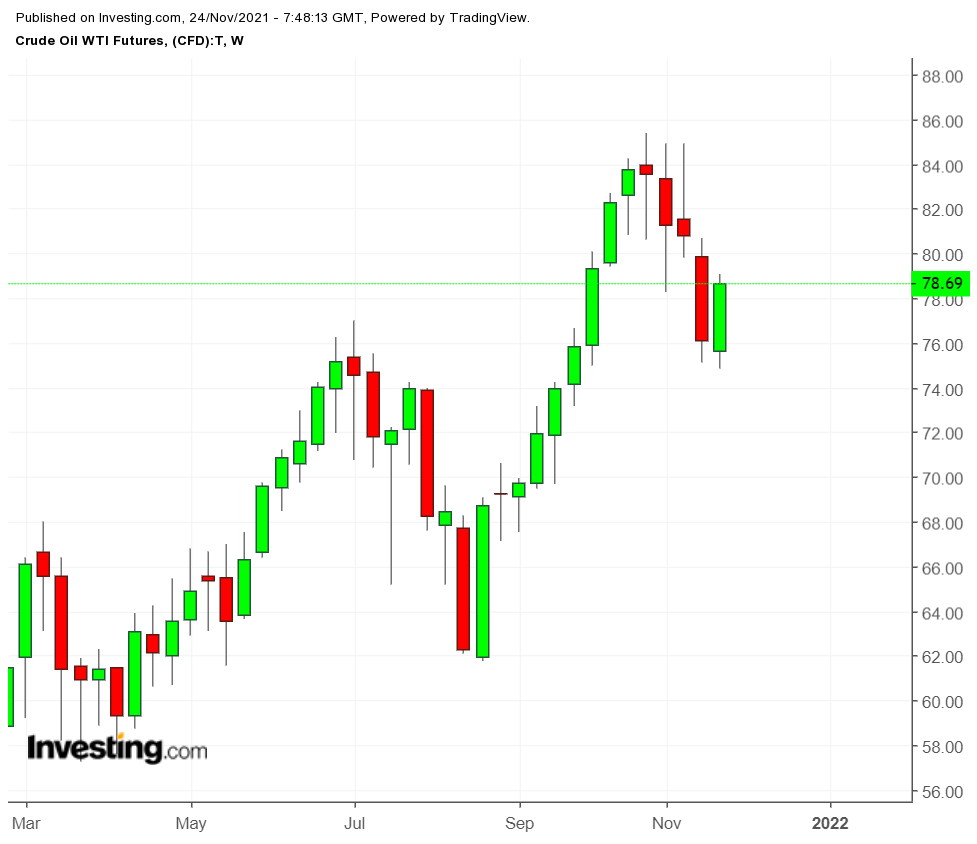On Tuesday, Nov. 23, the Biden administration finally announced its much-discussed plans to release crude oil from the United States’ Strategic Petroleum Reserve (SPR). The release is planned in coordination with several other nations including the U.K., India, Japan, South Korea, and China.

Here's what traders should know about this policy and how it may impact the market.
The Details
The Biden administration announced that 50 million barrels will be released from the SPR. This is the equivalent to about two and a half days of typical U.S. oil consumption based on 2019 demand numbers.
The total size of the U.S. SPR is over 700 million barrels. 18 million of the barrels to be released were already set to be sold as part of the budget reconciliation legislation that was passed by Congress years ago at the end of President Obama’s second term.
The current action will simply speed up the planned sale of these barrels and it now should be completed by Dec. 6. An additional 32 million barrels will be released as part of an exchange scheme in which companies can purchase barrels from the SPR with the commitment to resupply the strategic reserve with comparable barrels, plus additional volumes. The resupplies are slated to occur in 2022, 2023, and 2024.
India has agreed to release 5 million barrels from its SPR, which only contains about 39 million barrels. That’s a little more than 1 day's worth of consumption for India at 2019 levels.
The U.K. plans to permit its commercial entities to release a total of 1.5 million barrels of oil equivalent to the market on a voluntary basis. Japan also intends to release oil from its stocks, but the timing and amount has not yet been announced.
China and South Korea may also participate, but SPR release decisions from those countries have not been made yet. According to an industry consultant (not an official Chinese source) China could decide to release at least 7.33 million barrels.
Market Impact
Oil prices rose after this announcement. WTI gained as much as 2.6% on Tuesday. Some analysts believe that futures prices rose because of the new commitment to sell oil to the SPR in the future. The theory is that the SPR has agreed to buy in the future, making prices rise.
Other analysts believe futures prices rose because the market had already anticipated an SPR release and maybe even anticipated a larger release from the U.S. and other countries. Some market watchers may also be expecting retaliation from OPEC+ at its next meeting (discussed in more depth below).
Even before the SPR release was set, GasBuddy predicted that consumers in the U.S. might possibly see a drop in gasoline prices of 15 to 30 cents per gallon over the next several weeks. However, it does not expect an immediate drop in gasoline prices, because gas stations are unlikely to drop prices during Thanksgiving week (this week), which is one of the busiest travel times of the year in the U.S.
OPEC+ Reaction
So far, OPEC+’s reaction to this SPR release has been muted. There is speculation that OPEC+ could “retaliate” and halt its planned 400,000 bpd monthly production increases at its next meeting, which happens to be next Thursday, Dec. 2. This was mostly due to a Bloomberg headline based on a statement from the Riyadh-based International Energy Forum (IEF).
According to reporting from S&P Global Platts, OPEC is not concerned about SPR releases from the U.S. and China. An OPEC delegate was quoted as saying:
"There are no concerns at this time about the U.S. and China releasing crude from strategic reserves because if the market were to be oversupplied, OPEC+ has the option of not increasing or reducing production.”
UAE oil minister Suhail Mazrouei said that he does not think OPEC+ is going to change its plan. “As of now, we are going to meet on the 2nd [of December, and] we will look at the facts, we will look at the volumes in the market, and we will take the decision based on those facts,” S&P Global Platts reported.
It is possible that, at its virtual meeting next week, OPEC+ will determine that a pause in output increases is appropriate. However, such a decision would likely be based on factors that OPEC+ deems most important to the market—specifically global oil stockpiles and demand from China.
The U.S. SPR release won’t likely play a role in its decision-making. If OPEC+ decides to halt its planned 400,000 bpd increase next week, the decision will serve more to bolster Biden politically than to impact prices. The Biden White House would see a public win in any ability to make OPEC+ alter its plans.
